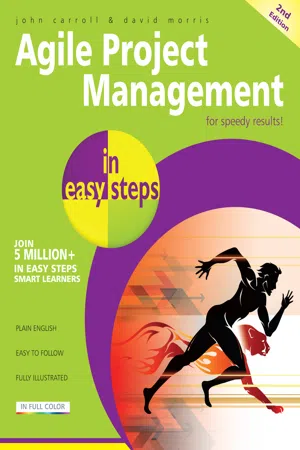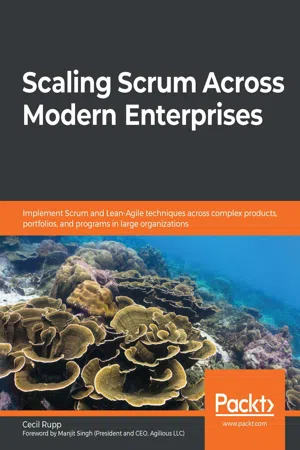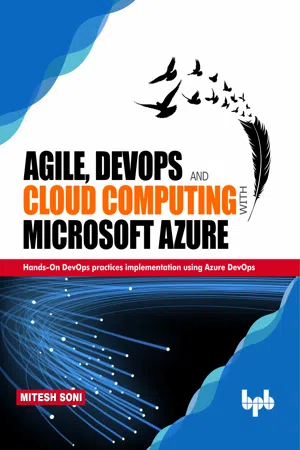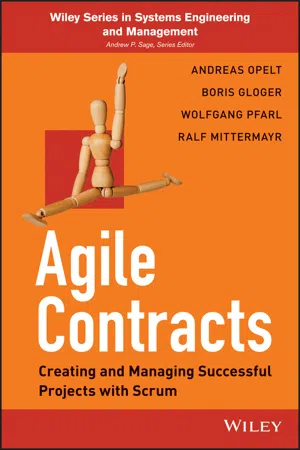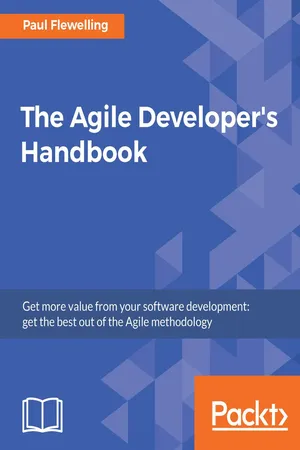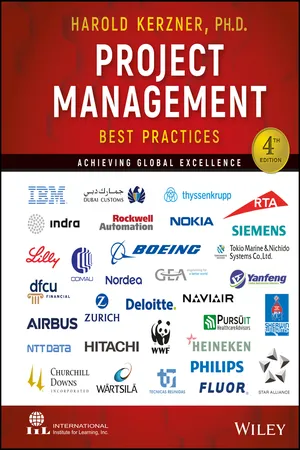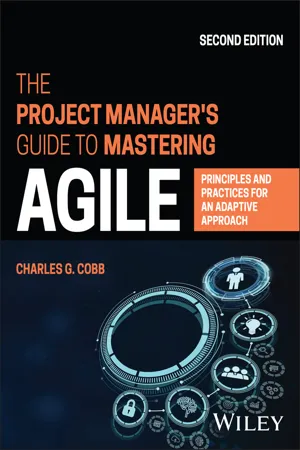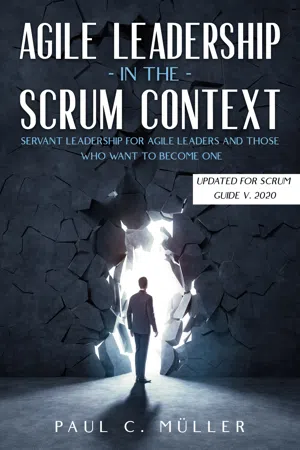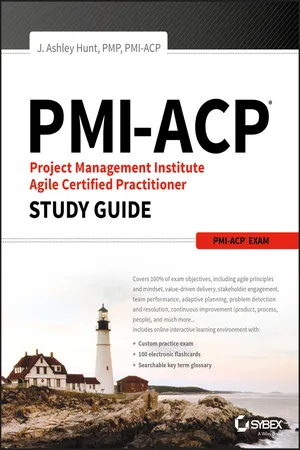Computer Science
Agile Scrum
Agile Scrum is a project management framework that emphasizes flexibility, collaboration, and iterative development. It involves breaking down work into small, manageable tasks and organizing them into short, time-boxed iterations called sprints. Scrum teams work closely together, regularly reviewing progress and adapting to changes, which allows for quick responses to evolving requirements and customer feedback.
Written by Perlego with AI-assistance
Related key terms
1 of 5
12 Key excerpts on "Agile Scrum"
- eBook - PDF
- Alan Dennis, Barbara Wixom, Roberta M. Roth(Authors)
- 2021(Publication Date)
- Wiley(Publisher)
Scrum is structured so that the development team rapidly and repeatedly produces actual working software that is ready for inspection in two- week to four-week cycles. Priorities established by the business define the development team’s “to-do” list. The team self-organizes to determine the best way to deliver the features in response to those priorities. Every two to four weeks, the team demonstrates real working software. At that point, business users can decide to release that software as-is or continue to enhance it for another two- to four-week cycle. Scrum is a versatile approach to developing software. Scrum has been used by many orga- nizations, both large and small, in an array of industries ranging from software development to financial services to industrial manufacturing. It has also been used in a wide range of software applications. Scrum has been used in data-heavy projects, website and video game development, commercial software, financial applications, embedded systems, and FDA-approved, life-critical systems, just to name a few categories. Overview of Scrum To begin to understand the Scrum development process, it is useful to look at the big picture. In Figure 13-5, we present a synopsis view of Scrum. We will briefly discuss Scrum at a high level and follow that with more details about its characteristics, roles, features, and processes. As depicted in Figure 13-5, ideas for features of the new system are provided by end-users, customers, the development team, and other stakeholders. These ideas represent the system’s requirements. These items are gathered and managed by the product owner, who represents the organization’s interests in this project. The product owner develops and manages a prioritized feature list, also called a product backlog, that serves as the development teams’ to-do list. - John Carroll(Author)
- 2015(Publication Date)
- In Easy Steps Limited(Publisher)
3ScrumScrum provides one of the most popular agile methods for developing complex products. It builds on and has been proved to work well with other agile components.Scrum Overview Scrum Theory Scrum Team Scrum Master The Sprint Sprint Planning Daily Scrum Sprint Review Sprint Retrospective Scrum Artifacts Product Backlog Sprint Backlog Progress Monitoring SummaryScrum is a framework for managing iterative and incremental product development. While it is most often used for software development it is also applicable to other types of projects.Scrum OverviewBackgroundHirotaka Takeuchi and Ikujiro Nonaka first described a new approach to the development of commercial products that would give increased speed and flexibility in 1986. They referred to this as the rugby approach as it is performed by a cross-functional team that “tries to go the distance as a unit, passing the ball back and forth”, very similar to the game of rugby.The term ‘Scrum’ then started being used to describe the approach in the early 1990s. In the game of rugby, a Scrum is the method of restarting after a minor infringement. Ken Schwaber and Jeff Sutherland collaborated to produce the definitive Scrum Guide, which is updated and made freely available every two years at www.scrumguides.orgThis chapter summarizes their approach, along with some helpful input from other practitioners.ScrumThey define a Scrum as “a framework within which people can address complex problems, while productively and creatively delivering products of the highest possible value”. The framework and terminology are simple concepts and easy to understand, and yet they are difficult to implement.It is important to understand that Scrum is only a framework for managing complex product development. It is not a technique or process for building products. For this reason, it works well with and complements software development techniques such as Extreme Programming (XP) and Lean Development. It also interfaces well with DSDM and Agile Project Management.- eBook - PDF
- Mark C. Layton, Steven J. Ostermiller, Dean J. Kynaston(Authors)
- 2022(Publication Date)
- For Dummies(Publisher)
CHAPTER 1 The Basics of Scrum 19 Twelve Agile principles The Agile Manifesto’s authors also agreed on 12 Agile principles. You can use these principles to make sure your approach is true to agile values: 1. Our highest priority is to satisfy the customer through early and continuous delivery of valuable software. 2. Welcome changing requirements, even late in development. Agile processes harness change for the customer’s competitive advantage. 3. Deliver working software frequently, from a couple of weeks to a couple of months, with a preference for a shorter timescale. 4. Business people and developers must work together daily throughout the project. 5. Build projects around motivated individuals. Give them the environment and support they need, and trust them to get the job done. 6. Face-to-face conversation is the most efficient and effective method of conveying information to and within a development team. 7. Working software is the primary measure of progress. 8. Agile processes promote sustainable development. The sponsors, developers, and users should be able to maintain a constant pace indefinitely. 9. Continuous attention to technical excellence and good design enhances agility. 10. Simplicity — the art of maximizing the amount of work not done — is essential. 11. The best architectures, requirements, and designs emerge from self-organizing teams. 12. At regular intervals, the team reflects on how to become more effective, and then tunes and adjusts its behavior accordingly. The principles don’t change, but the tools and techniques to achieve them can. While some principles explicitly reference software development, their application is much broader. Try replacing the word “software” with other words relevant to your context, such as “product,” “solution,” “functionality,” and so on. Some of the principles are easier to implement than others. Consider principle 2. Maybe some parts of your company (or group or family) are open to change and new ideas. - eBook - ePub
Scaling Scrum Across Modern Enterprises
Implement Scrum and Lean-Agile techniques across complex products, portfolios, and programs in large organizations
- Cecil Rupp(Author)
- 2020(Publication Date)
- Packt Publishing(Publisher)
By describing Scrum as a framework, the implication is that Scrum is a container that provides only minimal guidance on baseline practices, rules, artifacts, and events. The objective of the Scrum philosophy is to keep the essential framework lightweight and relatively simple to understand. Even then, Schwaber and Sutherland note, in The Scrum Guide ™, that Scrum is still challenging to master. Since Scrum is a framework, those who implement Scrum are free to include other business and engineering practices that support their approach to software and systems development. The framework concept is critical to understand as the intent of Scrum is to apply agile practices and empirical process control theories to resolve complex adaptive problems across any type of development or operational requirement. However, each organization and their Scrum Teams must choose the life cycle development and delivery practices that best support their needs in the moment. For example, your development team may use different software tools than other development teams and therefore require a different set of lower-level activities and best practices surrounding the use of those technologies. Likewise, your team may choose to implement test-driven development or model-driven development concepts within the framework of Scrum. Also, your team may implement variants for testing your software, based on the complexity and scale of the code you are developing. More importantly, as your team works together over time and continues to seek constant improvements, you may develop a set of best practices within the Scrum framework that are unique to your team. As with any development methodology, there is a flow to working within Scrum. The events and artifacts within the Scrum framework support empirical process control through transparency, inspection, and adaptation - eBook - ePub
Agile, DevOps and Cloud Computing with Microsoft Azure
Hands-On DevOps practices implementation using Azure DevOps
- Mitesh Soni(Author)
- 2019(Publication Date)
- BPB Publications(Publisher)
Programming in pairs or doing extensive code review. Unit Test Coverage of all code.Table 1.1: Agile based FrameworksWe will understand Scrum in detail in the following sections. In this book, we will use Scrum only in Azure DevOps.Scrum
According to the Scrum Guide,Scrum is a process framework that is lightweight and simple to understand within which people can address complex adaptive problems, while productively and creatively delivering products of the highest possible value.Scrum is widely used for application development where time to market is quick. It is used synonymously with Agile, which says a lot about its popularity. It is a part of the strategy in many organizations to become Agile within a specified duration. In a highly competitive market, technology innovations and ease of using innovations have helped in recognizing the true value of Agile and Scrum over the time.As DevOps is a culture and not a tool, technology or methodology; similarly, Scrum is a framework and not a process, technique, or a definitive method. We will discuss DevOps and Scrum in detail in the coming chapters. - eBook - ePub
- Jeff Furman PMP(Author)
- 2014(Publication Date)
- Berrett-Koehler Publishers(Publisher)
CHAPTER 14 Scrum Agile: The New Wave in Project ManagementA gile isn’t just about speed. Our new puppy, Mavis, can gallop the length of our hardwood floor, jump up on our bed, and course-correct in mid-air to avoid landing on my MacBook. She’s a fast runner, but it’s her agility that helps her respond to surprises.Speed and a change-friendly mindset are probably the two biggest differentiators of agile methodology over the traditional waterfall approach. Agile environments are faster in many ways, as explored in this chapter. But the goal isn’t just speed—it’s higher quality. Agile’s fast delivery allows customers to weigh in early and often on the product. This collaboration brings results that the customer is more likely to be happy with. Customers are free to suggest changes without getting knee-jerk pushback about scope-creep and risk. Change is welcome—in fact, it’s key to the process.If you are building a bridge or a skyscraper, waterfall is still the way to go. That kind of project requires very thorough up-front planning and a finalized blueprint before construction can start. But if you are creating a smartphone app, there likely will be shifting requirements and changing technologies that your deliverables will depend on. This makes scope a moving target, and that’s when agile methods are needed.In the past few years, scrum agile has become the method of choice for web and mobile apps, and it’s catching on fast for non-IT projects also. This chapter breaks down the key terms and concepts into easy-to-read Q&As, from sprints and standups to the scrum of scrums. It debunks common misconceptions about agile methodology versus waterfall. Networking and learning resources are provided, plus information about getting certified in scrum or agile.THE SPRINT AND RELATED CORE CONCEPTS
Q1. What is scrum agile - eBook - PDF
Agile Contracts
Creating and Managing Successful Projects with Scrum
- Andreas Opelt, Boris Gloger, Wolfgang Pfarl, Ralf Mittermayr(Authors)
- 2013(Publication Date)
- Wiley(Publisher)
Software developers in traditional processes are usually focused strongly on their work and ignore existing medium- to long-term business issues. With Scrum, however, the software developers are included in the strategic AGILE DEVELOPMENT BASED ON SCRUM 15 Figure 1.1 The process model: “Scrum Flow.” TABLE 1.2 Roles Meetings Artifacts Team Estimation meeting Product vision Product owner Sprint planning 1 Product backlog item (story) Scrum master Sprint planning 2 Product backlog (list of stories) Manager Daily scrum Sprint goal Customer Estimation meeting Selected product backlog End user Sprint review Tasks Sprint retrospective Sprint backlog Release plan Impediment backlog Product increment: usable software Definition of done Burndown chart 16 AGILITY: WHAT IS THAT? considerations in the following two ways, and developers begin to understand the context in which the success or failure of their work affects their firm and its customers. • On the one hand, the product owner develops a product vision for the product, either alone or together with the team. • On the other hand, the team always becomes involved in later strategic planning. In these two substrategies, product line strategy and organizational strategy higher-level strategies are obviously also factored in. Strategic planning provides us with a perspective from which, to assess whether a project can succeed, and with the ability to decide which approach will lead to achieving the goals. In summary, we are planning the following: • On the strategic level, the goals that we want to achieve • On the tactical level, the actions that are necessary to achieve these objectives The roles The strength of Scrum lies in the clear allocation of responsibilities and the separation of responsibilities of Scrum master, product owner, and team. In practice, to strengthen the situation intellectually within the teams or in an organization, we add the roles of customers, end users, and managers. - eBook - ePub
- Paul Flewelling(Author)
- 2018(Publication Date)
- Packt Publishing(Publisher)
At the end of this chapter, your team should have completed its first Sprint. You'll understand that to be successful, managing the delivery of a software product has to become a team sport and not just the responsibility of one person (the person we used to call the project manager). You'll also gain a clear idea of how visible workspaces will help you achieve that. We'll also describe several ways that you can measure the team's progress during the Sprint to help keep them focused and purposeful.Passage contains an image
Why Scrum is an excellent place to start
Scrum is a lightweight framework that provides the necessary mechanisms to get your team's mindset focused on the essential aspects of Agile software delivery. If you were to compare learning how to use Agile to learning to ride a bike, then Scrum could be seen as the training wheels that get us moving forward.That's not to say that Scrum is over-simplistic; as the saying goes, it's easy to learn but will take a lifetime to master. So while Scrum provides enough of a framework to get us started, it will also set us on the path to developing an Agile mindset.So, Scrum is a perfect place for an Agile team to start its journey. It is by far the most popular framework amongst fledgling Agile teams. This chapter aims to introduce the Scrum framework in a way that will help you to successfully transition a new-to-Agile team to this way of working.Passage contains an image
Iterations and iteration length
Scrum is an iterative, incremental delivery process. Each iteration, or Sprint, as they are known in Scrum, lasts between a minimum of 1 week and a maximum of 4 weeks, with the preference being for as short as possible. Shorter iteration lengths are what give our team its agility, as we get feedback at the end of each iteration; the sooner we get feedback, the faster we can adapt our approach.If your team is new to working iteratively, there's no denying that it will feel odd at first. Based on experience, my recommendation is that your team picks an iteration length that feels slightly shorter than comfortable. Taking this approach will give your team an opportunity to improve their process so that it fits the iterative style, and challenges them to change up their thinking.What this means is, if you think 4 weeks is comfortable in which to deliver a working increment, choose 2-week iterations. If you believe that 2 weeks would be more than comfortable, opt for 1-week iterations. - No longer available |Learn more
- Harold Kerzner(Author)
- 2018(Publication Date)
- Wiley(Publisher)
18 Agile and Scrum 18.0 INTRODUCTION As project management evolved, new techniques have appeared that are outgrowths of the changes in the project management landscape. Agile and Scrum are two such techniques. Figure 18–1 shows some of the changes that are taking place. Levels 2 and 3, which contain some of the core concepts for agile and Scrum, focus more on the characteristics for growth and maturity of project management whereas Level 1 contains basic principles and focuses on getting the organization to accept and use project management. 1 Because executives initially mistrusted project management and were afraid that project managers might make decisions that were reserved for senior management, we have learned that many of the characteristics of Level 1 were actually detrimental to effective project management implementation and served as significant roadblocks for agile and Scrum development - eBook - PDF
The Project Manager's Guide to Mastering Agile
Principles and Practices for an Adaptive Approach
- Charles G. Cobb(Author)
- 2023(Publication Date)
- Wiley(Publisher)
Scrum is also not limited to software development, but that is where it is most widely used at the current time. ◾ For that reason, much of the discussion in this book will be focused on software development, but it should be understood that Agile and Scrum are not limited to software development. For example, I used a Scrum approach to plan and organize the writing of this book. It should be noted that Scrum, in itself, is considered by some to be more of a product develop- ment framework rather than a project framework because it does not explicitly include any project planning/initiation/startup activities or project closeout phases/activities that would normally be required when using Scrum in a project context. Although these activities are not explicitly defined by Scrum, they can easily be added to extend Scrum for project work. Scrum, is, by definition, an empirical process as opposed to a “defined and predictive process.” The following is how these two types of processes are different: 1. Empirical process: The empirical process control model was defined to exercise or control the process via following some frequent adaptations as well as frequent inspections. ◾ ◾ It works best in situations with high levels of uncertainty where it is difficult, if not impossible, to clearly define the solution in advance and an experimental, trial-and-error approach is needed to converge on an acceptable solution. ◾ ◾ The term empirical process control model is based on the word empirical, which means the information is acquired by the means of experimentation and observation. 1 2. Defined and predictive process: “The defined process control model can be thought of as a theoretical approach. When a well-defined set of inputs is given, it is obvious that the same outcomes will be generated every time the program executes. With the well-understood technologies and stable requirements, one can very well predict a whole software project.” 2 Scrum Overview - eBook - ePub
Agile Leadership in the Scrum context (Updated for Scrum Guide V. 2020)
Servant Leadership for Agile Leaders and those who want to become one.
- Paul C. Müller(Author)
- 2021(Publication Date)
- Books on Demand(Publisher)
The empiricism of Scrum requires transparency, openness. This aspect of openness refers to the type of communication between all participants (which is closely related to the value "respect"). It also requires the willingness to allow and perceive different points of view and to learn from each other. Be open to collaboration with stakeholders and the environment. Open to sharing feedback and learning from each other. We recognize that we operate in a changing world where requirements will change and we will have to deal with unpredictable, unexpected situations. This mindset is central to realizing optimal value as a team for our customer.RespectWe show respect for people, their experience and their personal background. This respect is expressed in our communication within the team, but also beyond. The respect is also shown by the team doing their utmost to solve the users' problems and requirements and provide them with maximum value. We respect the Scrum framework. We respect our environment and see ourselves as part of a larger whole.CourageAn approach that develops things even before all the details are described takes courage. It means dealing with possible failure and mistakes and not letting setbacks stop you. The constant commitment to the further development of product, process and collaboration means the necessity to try new approaches; to make experiments. It goes without saying that experiments always include the possibility of mistakes or even failure. As a team and organization, we understand this as a prerequisite for further development. The courage it can cost people to take responsibility and make decisions themselves should not be underestimated. At the same time, however, it also requires courage to hand over responsibility and not to make all decisions oneself. To do this, we need to create a common framework that is stable enough to deal with mistakes and failures. Only then is there a basis for using new approaches and responsibilities.Roles in Scrum
Scrum is a framework in which people can tackle complex problems and develop products with the highest possible value in a productive and creative way. It is the most widely used agile framework.Within Scrum, self-organizing, cross-functional, and highly productive teams get the job done: creating valuable, releasable product increments. Scrum provides a framework that supports team learning through discovery, collaboration, and experimentation. - J. Ashley Hunt(Author)
- 2018(Publication Date)
- Sybex(Publisher)
In a lot of project management methodologies, the big focus is on the quality and the scope of the result. In Scrum and other Agile methodologies, however, the team is also looking at how the last sprint went with regards to people, relationships, and team interactions as well as processes, tools, and performance results. Once that occurs and the team has identified these items and placed them in a semblance of an order, identifying the major ones that went well and those that went not so well, it is easier to work through solutions. They have checked these items themselves for potential improvements, so it’s time to put together a plan to improve the way the Scrum team does its work. It is important to note that this is a very open and honest meeting. The team is transparent about their feelings on what went well, what did not go well, and what changes they would like to see made. By the end of the sprint retrospective, the Scrum team will have identified improvements that it will implement in the next sprint.Scrum EventsScrum events are an important part of the Scrum framework and are timeboxed for maximum effectiveness.In Figure 2.2 you will see a very simple version of Scrum events, including the length of time for each event.FIGURE 2.2Scrum EventsThe following are great guiding principles to get you into the mindset of Scrum:- A Team of between seven to nine members does the work.
- Team is cross functional.
- Team owns its process.
- Product owner provides the work requests.
- Product owner determines priority.
- Scrum Master provides support and coaching for the whole team.
- Scrum Master observes and helps the whole team adjust.
- Scrum Master guides the team.
- Daily Scrum reveals any adjustments needed.
- Work is done in short bursts of fewer than 30 days each (sprints).
- Work starts and stops with planning and review.
- Review demos the product.
- Retrospective allows for improvements to be identified and implemented.
As you can see, the Scrum framework has a well-rounded approach to time boxing or scheduling, transparent communication, and interactions. A large focus of the team is that it is self-managed and self-directed, and an Agile project manager/Scrum Master keeps the sprint running smoothly while promoting the reasons for it and the vision of the result. Finally, a product owner determines what is valuable to the customer today and helps the team see the vision by constantly communicating that value.As you will come to see, there are many other Agile methodologies. Beginning with Scrum, however, really lets you see that as you move forward, practicing agility is represented in all methodologies and you can turn around and start using some of the best practices immediately. Scrum is easy to explain and difficult to implement, but the more organizations begin to embrace or improve upon Agile best practices, the better they will be.
Index pages curate the most relevant extracts from our library of academic textbooks. They’ve been created using an in-house natural language model (NLM), each adding context and meaning to key research topics.

